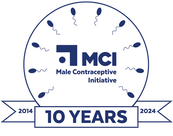|
The conversation around male contraception has been that it will be available “soon.” Multiple articles (such as this, this, and this) dating back to the early 2000s and further have claimed that a male pill is on the way. If the timeline that’s been promised is to be believed, we should all already be able to buy and use male contraceptives. Why can’t we? MCI recently conducted a survey of potential male birth control users, and a top finding from the survey is that all genders really want more male birth control options. The purpose of this post is to provide information about the way that a drug makes it to market and why male contraceptives are still in development. THE PROCESS The drug development process is a long, tedious, expensive ordeal that tries to answer the following questions:
The process for male contraceptive development can be varied and is not often linear, but the below is a representative pathway for some male contraceptive options. DRUG DEVELOPMENT The Aha! Moment A researcher in a lab finds some cellular function or defect: some component of reproduction that, when missing, seems to make men infertile. We’ll call this the “target.” Timeline: This is always happening with lots of different potential methods that different researchers are working on. But Does it Work? The researcher tests an animal (often a mouse) whose reproductive system has some characteristics similar to humans’. They want to know if their target can be changed in some way to make the animal infertile, because if it works in the animal, that might mean it will work in people. They might also be testing human sperm samples at this point. Timeline: Months to many years. Cost: Tens of thousands. Methods in this stage: There is a lot of exploration in different labs at this stage, with many researchers exploring leads that they have found. Is it Feasible to Actually Make a Drug for this Target? The researcher starts to develop the actual contraceptive that a man will take in the future. In this process, they’re trying to find a way to modify, control, and trigger infertility using their target, in a way that can somehow ultimately be delivered to a person. Can the drug be absorbed in the body? How might it be delivered...in a pill? A shot? A skin patch? Timeline: Several years. Cost: Hundreds of thousands. Methods in this stage: Lots! Some that MCI fund: Catsper and SLO3. These both affect sperm motility. Are We Sure? Lots of testing happens in animals and systems that represent human reproduction to make sure that the drug works in the right way, and is safe and viable as a contraceptive. Timeline: Several years. Cost: Hundreds of thousands. Methods in this stage: HIPK4, which MCI funds. This affects the production of sperm. But is it Safe? The researcher hones the drug even more to make sure that it’s safe. They also choose the right dosage form, like a pill, a shot, or an implant, and make sure that the dosage, how long it works, and effectiveness are just right. If there are other important features of the drug, like reversibility, that also can be tested here. Ultimately, researchers are ensuring the drug is up to the rigorous US FDA standards for approval. Timeline: Several years. Cost: Hundreds of thousands to millions. Methods in this stage: Eppin (sperm motility), ADAM (blocks vas deferens), VasDeBlock (blocks vas deferens), Vasalgel (blocks vas deferens). CLINICAL TRIALS It Works! But…Does it Work in Actual People? If the drug is shown through the above steps to be safe, effective, and have a reliable dosage and dosage form, then the researcher applies for an Investigational New Drug application, allowing the drug to move to human studies. Because they can make so much money on a drug that is later able to be sold, investors and pharma companies sometimes like to come in and invest somewhere in the process below. Phase I Clinical Trial: This is the first time a researcher tests their drug in real humans. In this stage, they want to see if the contraceptive has side effects at different dosages and how it’s handled by the body. Most drugs move forward from this stage. Timeline: Months to 2 years. Cost: 2-5 million. Methods in this stage: Bambang Prajogo (impacts sperm motility or fertilization) is being tested in the equivalent of this stage in Indonesia, but it won’t be available in the US until it goes through the American process, H 11-beta-mntdc, DMAU. Phase II Clinical Trial: In this stage, people continue to be tested to see what the side effects are and how safe the contraceptive is. The drug is also tested for how well it works. About a fifth drugs move forward from this stage. Timeline: Months. Cost: Between $5-20 million. Methods in this stage: RISUG (blocks vas deferens) is being tested in the equivalent of this stage in India, but it won’t be available in the US until it goes through the American process, NES-T. Phase III Clinical Trial: The goal of this stage is to see if the contraceptive actually benefits men and couples, and also shows researchers if there are any long-term or rare side effects, since this time it’s tested on many more people. Testing on a large, diverse group of people provides more information about the effectiveness of the drug. About a third of drugs that make it to phase three move on. Timeline: 3-4 years. Cost: Between $10-50 million. Then What? Once a drug makes it through these three phases, it can be approved and then can be marketed. Phase IV Clinical Trial: “Post-Market Safety Monitoring” happens here. During this period, the safety, side-effect profile, and efficacy of the drug is monitored. Timeline: once drug becomes available, ongoing. This hasn’t happened with male contraceptives yet! When it does, lots of things have to happen. The new contraceptive will be in the news, and will be marketed to consumers. Doctors will have to be trained on how to use it, and will have to be motivated to prescribe it to their patients. Insurance will have to cover it. People will have to know it exists and want to use it. So, why isn’t male birth control available yet? Because it takes a really long time to develop a drug, and because it’s impossible to tell in early stages which drugs are actually going to work out. It might look like a new drug is really promising (you’ve seen the headline: “male birth control, coming soon!”), but it might turn out with more research that it doesn’t work in a pill or a shot or a cream or an implant or any other way we deliver drugs. Maybe it turns out that it causes unwanted side effects. Maybe it works great, but it’s really inconvenient for men and couples to use…and the process slows down as researchers go back to the drawing board. Often, drug development research is funded by a pharmaceutical company that will ultimately sell the drug that comes from the research. But this isn’t happening with male contraception; rather, individual scientists and smaller organizations are working to develop new male contraceptive methods (more about that here). The pharmaceutical industry is currently not interested in developing innovative contraceptive products; they are satisfied with making minor modifications of the products currently available. This is part of the reason that development has been even slower than it is to develop some other drugs —money is tight, and each researcher is essentially working on their own or with close collaborators with what financial and scientific support they’re able to wrangle themselves. At Male Contraceptive Initiative, we know that new methods are important for men and their partners, and we know that they are on their way. That’s why we financially support the researchers working on the new male contraceptive methods, advocate for male contraceptive funding and acceptance, and catalyze conversations around male birth control. The Drug Development Pipeline, Simplified WANT MORE MALE CONTRACEPTIVE OPTIONS? HERE’S HOW YOU CAN ADVOCATE: Talk to people! Male birth control is coming—it will just take a while. There are a lot of male contraceptive targets and drugs in the pipeline, and researchers are constantly coming up with more ideas. It remains to be seen which ones will make it to the market, but there are a lot of good potential options coming for couples. We want people to be talking about male contraceptives, so that when they finally hit the market, men feel safe and comfortable taking them, couples are ready to incorporate them into their birth control plan, and providers know how to insert or prescribe them. Talk to your partner, your friends, your kids, and your doctor to see what they think, and share information with them. Stay informed and join the male birth control conversation! Follow us on Instagram, Twitter, YouTube, LinkedIn, and Facebook, or reach out to us and tell us what you think about male contraception. We post information and updates about male contraception, and have lots of opportunities for you to share your perspective and ideas about male birth control. Donate! It’s incredibly expensive to make a new drug. Donations to Male Contraceptive Initiative provide a much-needed lifeline of financial support to the researchers developing the methods. Reference for costs: Martin et al. How much do clinical trials cost? Nat Rev Drug Discov. 2017 Jun;16(6):381-382. doi: 10.1038/nrd.2017.70. Epub 2017 May 19. Comments are closed.
|
Categories
All
Archives
June 2024
|
|
|
Donate to Male Contraceptive InitiativeYour generous donation makes a difference!
|
© Male Contraceptive Initiative. All rights reserved.


 RSS Feed
RSS Feed
